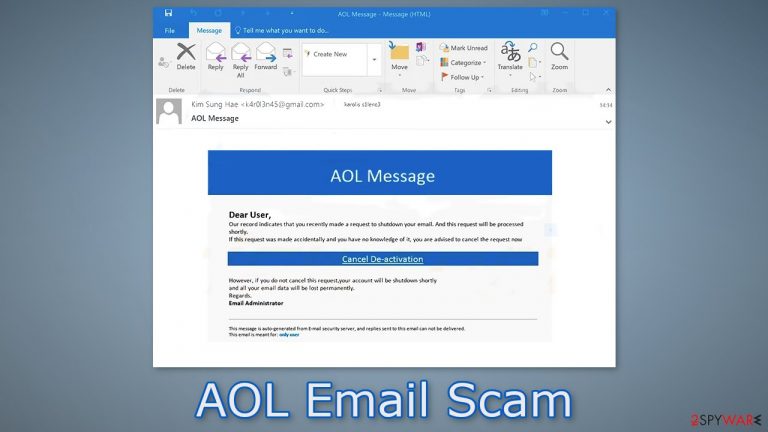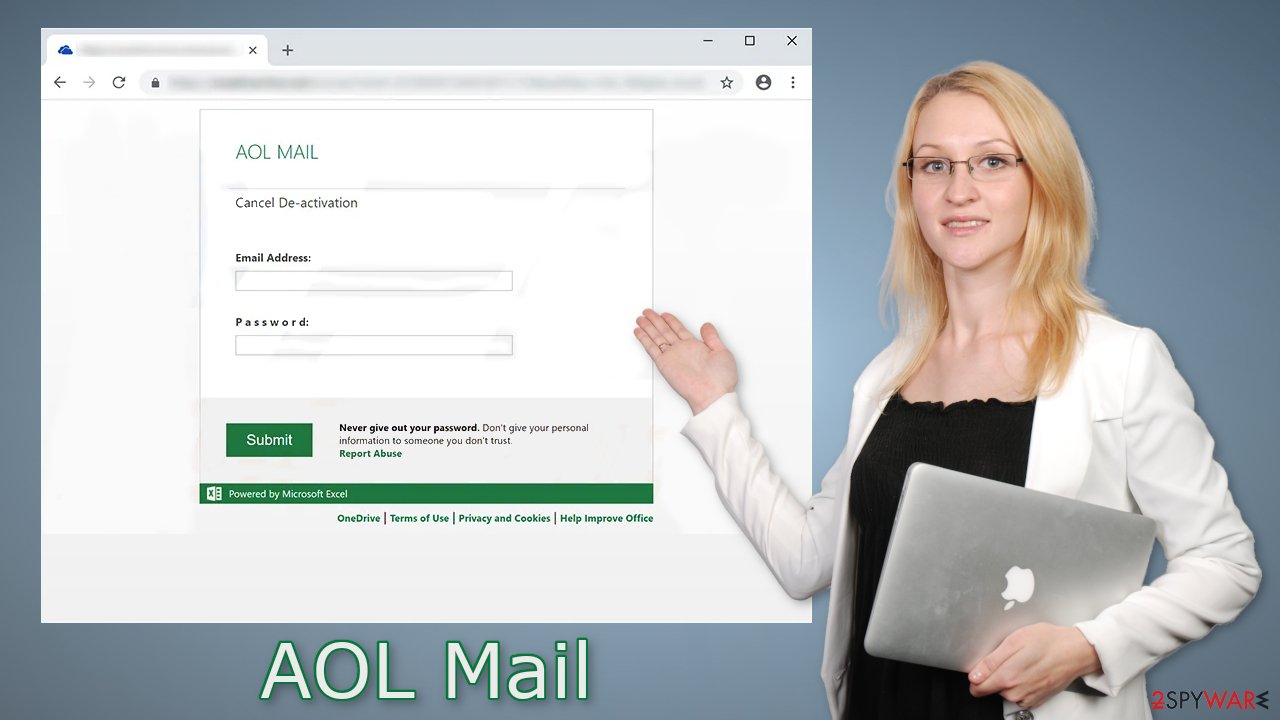AOL Email Scam (fake) - Free Guide
AOL Email Scam Removal Guide
What is AOL Email Scam?
AOL Email Scam might lead to monetary losses and even identity theft if users are tricked by social engineering methods

“AOL Email Scam” is a spam campaign created by cybercriminals to trick users into providing AOL email account credentials. Scammers use phishing[1] techniques to convince people that their accounts will be soon shut down and they should take action if they do not want it to happen.
| NAME | AOL Email Scam |
| TYPE | Phishing attempt |
| SYMPTOMS | Users receive an email disguised as a message from AOL |
| DANGERS | Passwords and login details may be hijacked; users may suffer from financial losses and even identity theft |
| ELIMINATION | If you opened an email with a malicious attachment scan your computer with anti-malware tools |
| FURTHER STEPS | Use FortectIntego to clear your browsers and get rid of any remaining damage |
AOL Email Scam in detail

The full message crafted by threat actors reads as follows:
AOL Message
Dear User,
Our record indicates that you recently made a request to shutdown your email. And this request will be processed shortly.
If this request was made accidentally and you have no knowledge of it, you are advised to cancel the request nowCancel De-activation
However, if you do not cancel this request,your account will be shutdown shortly
and all your email data will be lost permanently.
Regards.
Email AdministratorThis message is aut-generated from E-mail security server, and replies sent to this email can not be delivered.
This email meant for: only user
The supposed email from AOL states that the administrators received a request to delete the email account. If users did not make this request they are encouraged to click on the link provided in the email and cancel the deletion. However, the link leads to a fake AOL Mail website with a login screen.
If users enter their information in the provided fields, the data would be sent to a remote server owned by the cybercriminals. This would give crooks full access to users' email accounts. It is important to mention that AOL has nothing to do with this fraudulent campaign and it was completely manufactured by fraudsters.
They usually send out thousands of emails hoping that at least some people would fall for it. Criminals can do many things with the login details. One of them is trying to contact the victims' contacts and ask them for money, hijack other accounts by using the “restore password” function on social media platforms, etc. Therefore, stolen email credentials can lead to privacy issues, financial loss, and even identity theft.[2]
Email scams use social engineering
We previously wrote about many other email scams, like the Geek Squad email, Microsoft Account Deactivation email, and “Unfortunately, there are some bad news for you” email. Usually, cybercriminals try to deliver malware[3] into victims' accounts via infected email attachments.
They are also often disguised as official and urgent letters from well-known companies and organizations. Crooks use the branding, logos, and trust that these companies have built over the years with their customers. If you think you were tricked by a deceptive message, there are some actions you should take to protect yourself:
- If you think you gave away your password to malicious individuals change it as soon as possible. Cybercriminals collect stolen credentials and then often sell them to other groups that use them. If you change your password quickly, there is a chance that criminals will not have enough time to do any damage.
- If you entered your credit card information – contact your bank as soon as possible and explain what happened. You will probably be able to cancel your compromised credit card and get a new one.
- If you notice any signs of identity theft – you should contact the Federal Trade Commission. They will collect information about your situation and create a personal recovery plan.
- If you opened a malicious attachment – your computer is probably infected, you should scan it with professional security tools, like SpyHunter 5Combo Cleaner or Malwarebytes.
Check your system for malware infections
If you suspect that you have opened an email with an infected attachment, you should take care of the threat. We recommend using SpyHunter 5Combo Cleaner or Malwarebytes security tools that will scan your machine, eliminate it, and prevent such infections in the future by giving you a warning before a malicious program can make any changes.
Crooks often disguise their malicious programs as “handy” tools so they would be more difficult to identify for the average user. People also often fail to eliminate all the related files and entries which could lead to the renewal of an infection. The program could have any name and icon, so this step is best performed by anti-malware tools.
However, if manual removal is what you prefer, we have instructions for Windows and Mac machines:
Windows 10/8:
- Enter Control Panel into Windows search box and hit Enter or click on the search result.
- Under Programs, select Uninstall a program.

- From the list, find the entry of the suspicious program.
- Right-click on the application and select Uninstall.
- If User Account Control shows up, click Yes.
- Wait till uninstallation process is complete and click OK.

Windows 7/XP:
- Click on Windows Start > Control Panel located on the right pane (if you are Windows XP user, click on Add/Remove Programs).
- In Control Panel, select Programs > Uninstall a program.

- Pick the unwanted application by clicking on it once.
- At the top, click Uninstall/Change.
- In the confirmation prompt, pick Yes.
- Click OK once the removal process is finished.
Mac:
- From the menu bar, select Go > Applications.
- In the Applications folder, look for all related entries.
- Click on the app and drag it to Trash (or right-click and pick Move to Trash)

To fully remove an unwanted app, you need to access Application Support, LaunchAgents, and LaunchDaemons folders and delete relevant files:
- Select Go > Go to Folder.
- Enter /Library/Application Support and click Go or press Enter.
- In the Application Support folder, look for any dubious entries and then delete them.
- Now enter /Library/LaunchAgents and /Library/LaunchDaemons folders the same way and terminate all the related .plist files.

Repair the damaged operating system
Performance, stability, and usability issues, to the point where a complete Windows reinstall is required, are expected after malware infection. These types of infections can alter the Windows registry database, damage vital bootup and other sections, delete or corrupt DLL files, etc. Once a system file is damaged by malware, antivirus software is not able to repair it.
This is why FortectIntego was developed. It can fix a lot of the damage caused by an infection like this. Blue Screen errors,[4] freezes, registry errors, damaged DLLs, etc., can make your computer completely unusable. By using this maintenance tool, you could avoid Windows reinstallation.
- Download the application by clicking on the link above
- Click on the ReimageRepair.exe
- If User Account Control (UAC) shows up, select Yes
- Press Install and wait till the program finishes the installation process
- The analysis of your machine will begin immediately
- Once complete, check the results – they will be listed in the Summary
- You can now click on each of the issues and fix them manually
- If you see many problems that you find difficult to fix, we recommend you purchase the license and fix them automatically.

How to prevent from getting spam tools
Choose a proper web browser and improve your safety with a VPN tool
Online spying has got momentum in recent years and people are getting more and more interested in how to protect their privacy online. One of the basic means to add a layer of security – choose the most private and secure web browser. Although web browsers can't grant full privacy protection and security, some of them are much better at sandboxing, HTTPS upgrading, active content blocking, tracking blocking, phishing protection, and similar privacy-oriented features. However, if you want true anonymity, we suggest you employ a powerful Private Internet Access VPN – it can encrypt all the traffic that comes and goes out of your computer, preventing tracking completely.
Lost your files? Use data recovery software
While some files located on any computer are replaceable or useless, others can be extremely valuable. Family photos, work documents, school projects – these are types of files that we don't want to lose. Unfortunately, there are many ways how unexpected data loss can occur: power cuts, Blue Screen of Death errors, hardware failures, crypto-malware attack, or even accidental deletion.
To ensure that all the files remain intact, you should prepare regular data backups. You can choose cloud-based or physical copies you could restore from later in case of a disaster. If your backups were lost as well or you never bothered to prepare any, Data Recovery Pro can be your only hope to retrieve your invaluable files.
- ^ Phishing. Wikipedia, the free encyclopedia.
- ^ Bev O'Shea. Identity Theft: What It Is, How to Prevent It, Warning Signs and Tips. Nerdwallet. Finance Advice.
- ^ Malware. Malwarebytes. Cybersecurity Basics.
- ^ Tim Fisher. Blue Screen of Death (BSOD). Lifewire. Software and Apps.
